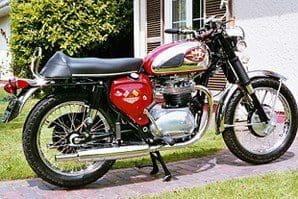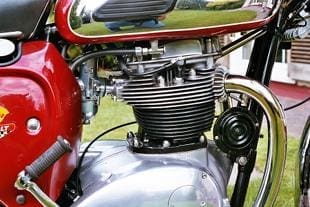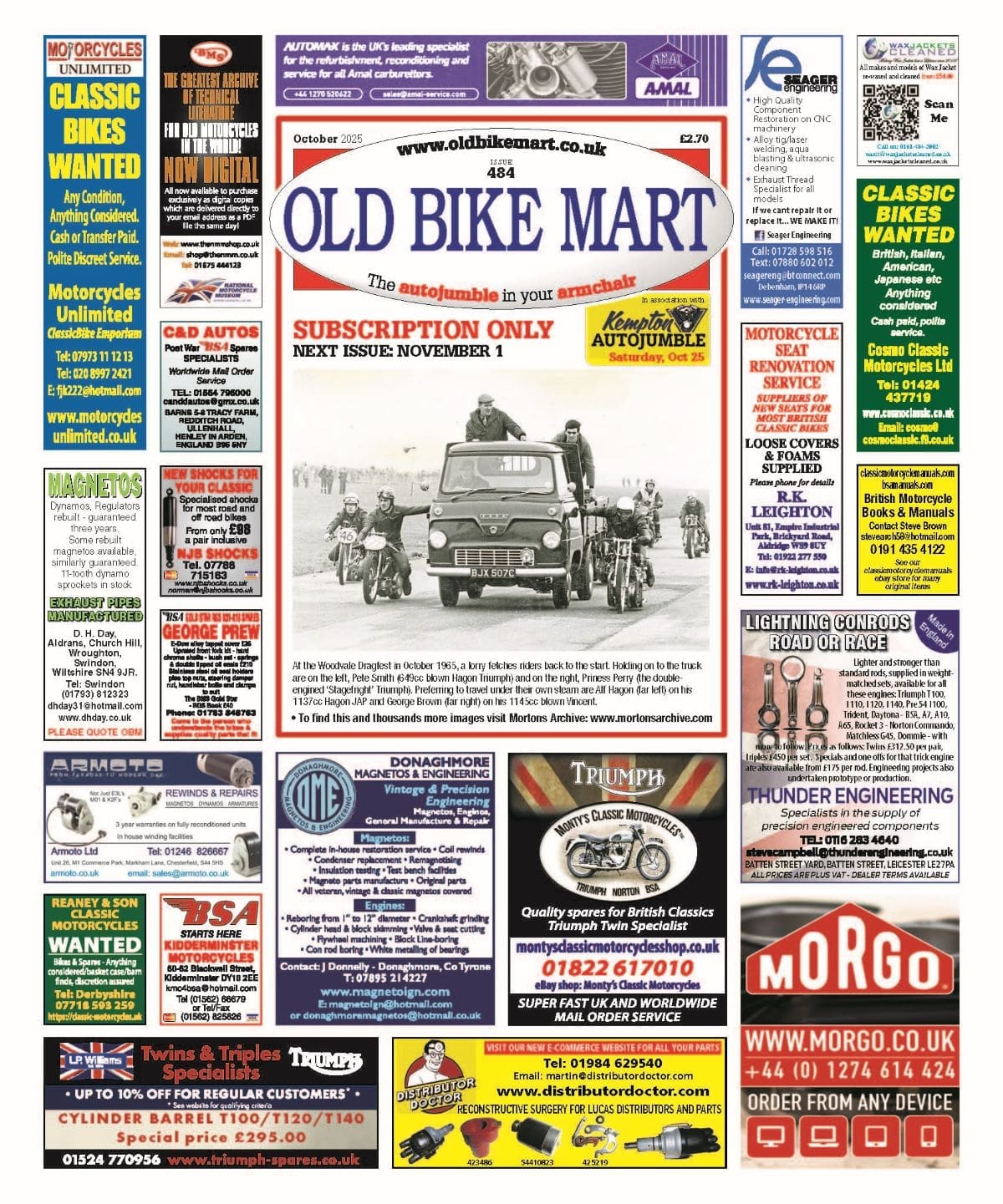
BSA introduced their unit-construction 650 parallel twin in 1962. The 654cc machine started life as the A65 Star basic model, with various offshoots developing through the decade. The Lightning versions sported twin carbs, as did the highly-strung Spitfire which was intended for competition use. The single-carb Thunderbolt fulfilled more of an everyday, touring role, and by 1968 it sported 12-Volt electrics, a Concentric carb, two-way fork damping and a three-spring clutch to go with its four-speed gearbox.
The 75mm by 64mm motor typically ran 9:1 compression to produce 42bhp at 6800rpm. Fully fuelled with four gallons of gas the bike weighed nearly 400lb, so its top speed was slightly less than the 100mph mark, with a standing quarter taking 15.5 seconds or so. In 1968, the Thunderbolt would go from zero to 60mph in 7.4 seconds. The twin-carb Lightning of the same year was only marginally quicker – 15.29 seconds to cover a standing quarter mile and with a 102mph top velocity – for all that it claimed to house an extra half dozen horses.
The BSA range underwent a major (and not universally appreciated) revamp for 1971, so the final years of the previous decade are considered by many to be the easiest to live with and most desirable unit construction machines. Although not the most glamorous of the BSA 650 models, the A65T is a popular choice for modern classic bike fans.
Enjoy more classic motorcycle reading, Click here to subscribe to one of our leading magazines.
 Roy Bacon reckons that; ‘for riding, a well-sorted Thunderbolt from the late 1960s could give the best combination of virtues.’ Similarly ‘Cycle’ magazine said that the 1968 bike was ‘one of the best-designed motorcycles that we have had the pleasure of testing’.
Roy Bacon reckons that; ‘for riding, a well-sorted Thunderbolt from the late 1960s could give the best combination of virtues.’ Similarly ‘Cycle’ magazine said that the 1968 bike was ‘one of the best-designed motorcycles that we have had the pleasure of testing’.
Owner Tony Clements feels much the same about his own 1968 Thunderbolt which has just won the Best Bike award at the 2010 Walsall Classic Show. Tony bought the bike back in 1997 and cut his classic teeth on it. ‘This was my first venture into British iron classics’ he says, ‘and it taught me a lot of skills which I’d since put to good use!’
The road testers of the era were aware that all was not wonderful back at Small Heath when the A65 left the factory. ‘Unfortunately, what is obviously an outstanding engineering exercise has been negated by a lack of attention down on the assembly lines. Blessed with beautifully proportioned lines and as clean an engine-transmission assembly as there has been on the market, the Thunderbolt has been flawed by indifferent workmanship’ said Cycle magazine. However, those kind of issues are straightforward to resolve with modern materials – so long as the owner has the dedication and application to do the job right.
Tony’s Beezer cost £950 to buy and around another £4000 to bring up to scratch – and that’s just the cost of the parts. Tony did the majority of the work himself; ‘paintwork, polishing, rebuilding and even manufacturing parts where possible’. The A65 was complete but ‘it had been severely butchered by several previous owners’ so it was given a top-to-bottom, nut and bolt restoration. It’s no great surprise that this bike regularly wins awards when Tony rides it to shows, because he has paid enormous attention to detail during the rebuild. For instance; ‘every visible fastener has been re-made in stainless steel.’ Likewise, going ‘the extra mile’ on the Candy Red paintwork was definitely worth it, says Tony. ‘The overall effect is great!’
Tony used and is happy to recommend SRM for his engine re-grind, and Traditional Plating for the chrome work; Central Wheels for the spokes and rims; RS Paints who matched that special colour, and Lightning Spares for general BSA bits.
Tony incorporated a couple of modern modifications into his restoration. He’s pleased with performance of the taper roller head bearings: ‘fit and forget: great!’, and a Boyer electronic ignition system which ‘is a must, and cost under £100’. The SRM clutch conversion ‘expands with engine temperature but has very good thrust bearing.’
After suffering a couple of teething problems during its shakedown period (the original coils failed: ‘I should have replaced them to start with’ says Tony), the A65 is now ‘very reliable. It starts well, ticks over well, and runs great.’
Tony has considered fitting a Mikuni carb because ‘British Amals are hit and miss, to say the least’ but feels that the Japanese carb would spoil the A65’s appearance, so he’s stayed with the original set up. He reckons that A65s are ‘very under-rated. Spares are freely available and they run very well and reliably…’
So if you’re considering a purchase, Tony says: ‘go for it!’
Classic and British bikes like this one appear every month in the pages of RealClassic magazine. Our in-depth articles by expert and enthusiast authors reflect the old bikes we buy and ride in the real world: frequently fabulous; occasionally awful, but always interesting…


